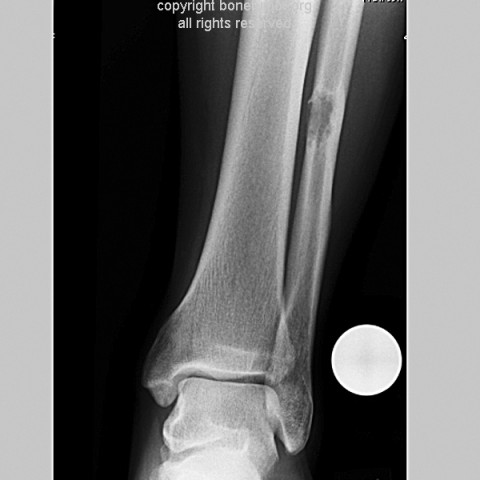Case Identification
Case ID Number
Tumor Type
Body region
Position within the bone
Benign or Malignant
Clinical case information
Case presentation
The patient is 51 and in generally good health with severe leg pain. He was cutting trees in his yard when a falling limb struck his leg. An abnormality in the left mid distal fibula was noted.
Radiological findings:
On oncologic examination, the overall status, and regional status of the lesion is assessed. There is no local or regional lymphadenopathy, and no lymphadenopathy is noted in the draining lymph chain. No central lymphadenopathy is noted. There is no café au lait spot, or other unusual skin lesion. The patient does not appear chronically ill or cachectic.
On musculoskeletal examination, the patient is ambulatory using two crutches because of pain in the left leg. There is noticeable swelling around the mid to distal fibula. Distally, the neurovascular status of the foot is normal. There is no popliteal or inguinal lymphadenopathy. No distinct masses palpable. There is point tenderness around the area of the impact from the accident the patient had one week ago. There is no visible bruising, no break in the skin, no ecchymosis. No skin changes whatsoever. The only findings are point tenderness and swelling.
Xrays, a bone scan, and an MRI shows a small lesion in the fibula that has eroded the medial cortex, has a granular appearance, measures about 2 1/2 centimeters in length and about 2 cm in medial lateral size. It has a somewhat lobulated appearance. There is no periosteal reaction. There is no matrix calcification. It appears to be destroying the medial cortex of the fibula, and there is a soft tissue mass.
A CT scan and the MRI show a lobulated, lytic, destructive process, having obliterated the medial cortex of the fibula, with no periosteal reaction, no matrix calcification. There is considerable perilesional edema. The lesion has low T1 signal and high T2 signal.
On musculoskeletal examination, the patient is ambulatory using two crutches because of pain in the left leg. There is noticeable swelling around the mid to distal fibula. Distally, the neurovascular status of the foot is normal. There is no popliteal or inguinal lymphadenopathy. No distinct masses palpable. There is point tenderness around the area of the impact from the accident the patient had one week ago. There is no visible bruising, no break in the skin, no ecchymosis. No skin changes whatsoever. The only findings are point tenderness and swelling.
Xrays, a bone scan, and an MRI shows a small lesion in the fibula that has eroded the medial cortex, has a granular appearance, measures about 2 1/2 centimeters in length and about 2 cm in medial lateral size. It has a somewhat lobulated appearance. There is no periosteal reaction. There is no matrix calcification. It appears to be destroying the medial cortex of the fibula, and there is a soft tissue mass.
A CT scan and the MRI show a lobulated, lytic, destructive process, having obliterated the medial cortex of the fibula, with no periosteal reaction, no matrix calcification. There is considerable perilesional edema. The lesion has low T1 signal and high T2 signal.
Laboratory results:
None relevant
Differential Diagnosis
This bone lesion has an active appearance. No definitive diagnosis is possible based on history and imaging studies.
Pathology results:
See images for pathological features.
Special Features of this Case:
This active lesion was discovered by a freak accident. Usually incidentally discovered lesions are latent.
Image

Case ID Number
Image Types
Image modality
Tumor Name
Tumor Type
Benign or Malignant
Body region
Bone name
Location in the bone
periosteal reaction
position within the bone
Tumor behavior
Tumor density









